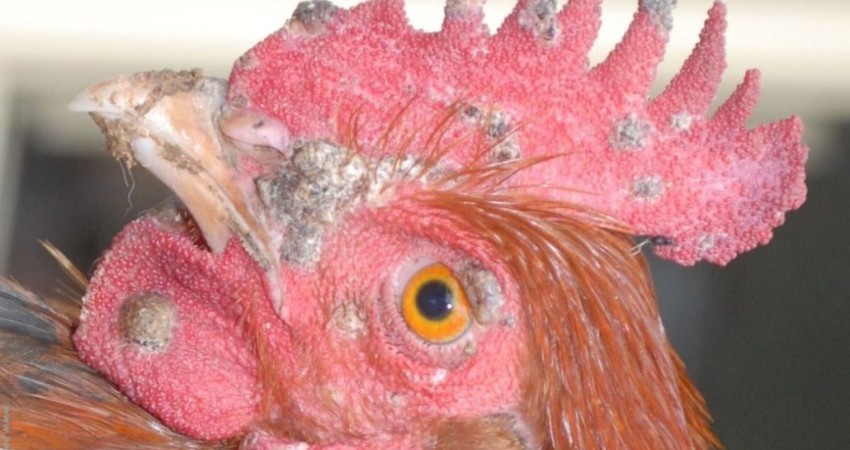

Fowl pox is caused by a pox virus and mostly affects chickens. There is also a pigeon pox virus and a turkey pox virus.
There are three possible ways in which the virus can be spread:
Commonly, the virus is shed from Fowl pox wounds on affected birds and enters its next victim through skin wounds. (Normal healthy skin will act as an effective barrier to Fowl pox virus).
Biting insects can carry the virus from one bird to another.
Pox viruses that infect mammals can be spread through the air and it is thought that this may be a way for Fowl pox to be transmitted
Once in the skin, the virus reproduces to cause ‘pocks’. These start off as raised areas which then burst releasing a tiny amount of pus to leave scab-like crusted raised areas, which are often brownish colour. These wounds are mostly seen on featherless skin such as the legs, comb, eye lids and wattles. This is called the ‘dry form’ of Fowl pox.
Signs of the ‘dry form’ are raised crusted areas on the featherless areas of the bird causing some mild irritation. These birds may stop laying and lose weight. In severe cases if the eye lids are affected the birds can find it hard to open their eyes. Birds with the ‘dry form’ rarely die. After about 14 days the pocks heal but can sometimes leave a tiny scar.
Much more rarely, the virus can infect the mouth, the oesophagus (food pipe) and the trachea (windpipe) initially to form white lumps in these areas, but subsequently these areas join together to create a layer of mucus, pus and dead cells from the mouth lining. This is called the’ wet form’. This mucus/pus/dead cell can obstruct the trachea (windpipe) making it difficult for the birds to breathe (in severe cases, choking the bird) and it can be very painful making it hard for the bird to eat. Birds with the ‘wet form’, if severe enough, can die.
There is no specific treatment for Fowl pox but it is worth taking them to your vet, especially if they have the ‘wet form’ as they may prescribe antibiotics to prevent secondary bacteria making the problem worse. If your bird is restless and not eating as much food as normal it is worth giving them Chicken Vet Amino + (which contains amino acids- the building blocks of protein) to compensate for their reduced appetite. Birds may find it very painful to eat but may find it less painful to drink; therefore supplements in their water will be of benefit.
As an owneer you must first of all prevent an outbreakof the disease by only buying birds from a reputable source i.e. not local markets. Always check your chicken for any wounds or unusual behaviour before you make a purchase and take it home. Many conditions such as Fowl pox can take a few days or even weeks to present themselves following infection so it is recommended to quarantine your chickens for three weeks after purchase.
Biting insects can spread Fowl pox and as such you should try to keep control of the local insect population. Chicken Vet has a wide range of insect control products.
As with all diseases improving overall hygiene and keeping the birds as stress free as possible will help. The Fowl pox virus is very resistant and can survive in the environment for years. Always ensure that you use an approved disinfectant such as Interkokask. The concentrated version is DEFRA approved to kill bacteria, viruses, fungi, coccidiosis, worm eggs and red mite at the correct dilutions and application.
 Contact Jaguza Support
Contact Jaguza Support